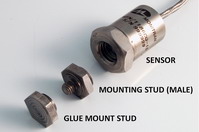 Andy Anthony, Operations Director with Monitran, discusses the importance of vibration sensor selection, placement and use for condition-based predictive maintenance.
Andy Anthony, Operations Director with Monitran, discusses the importance of vibration sensor selection, placement and use for condition-based predictive maintenance.In the December issue of Engineering Maintenance Solutions Donald Lyon, MD of Monitran, explained how cost-effective condition-based predictive maintenance (PM) strategies can be formed around the intelligence gathered from vibration monitoring and analysis. That article detailed the top-level benefits of such strategies. Now, we need to drill deeper into the subject, as the value of the data recorded, and analysed or acted on, will only be as good as the sensors utilised and how they are positioned.
Where vibration sensors are concerned, they must be matched to their intended application, otherwise they are likely to provide misleading information and, in some circumstances, you might be shortening their working life. You may also be putting machinery at risk by allowing developing problems to go undetected. Sensors are far cheaper than lost production and capital machinery. Further, use of the wrong type of sensor may contravene industry regulations, such as those pertaining to the use of equipment in hazardous areas.
However, with so many sensors available, where does one start?
Intended Use & Location
The first thing to ask is: what is it you wish to do? The answer will typically be one of the following:
• I wish to analyse and monitor vibration – for example, in order to understand the nature of vibration within a machine or structure, or to determine if or how parts might be wearing.
• I wish to monitor continuously vibration levels and for actions to be automatically taken, such as shutting down machinery, if levels exceed certain limits.
For analysis purposes, sensors with AC outputs should be employed. This output can be fed into an instrument, such as a spectrum analyser or oscilloscope, to yield information on the amplitude and structure of the vibration.
For condition-based (continuous) monitoring, with a view to protecting machinery, sensors with DC outputs are best employed. They produce a DC output proportional to velocity or acceleration, in the range 4-20mA, and so are ideal for interfacing with monitoring and shut-down circuitry.
Having decided on which fundamental type of sensor to use, the next stage is to make best use of its output. For example, one style of AC sensor might operate across the range ±80g but be available with different sensitivities, for example 10, 50, 100, 500 and 1,000mV/g.
If exposed to its full operating range of ±80g, a sensor with a sensitivity of 100mV/g would output -8 to 8V, and within this range a change in acceleration of 1g would correspond to a change of 100mV. However, if the sensor is likely to be exposed to only ±8g, then it would be wiser to select a sensor with a sensitivity of 1V/g, as a change of 1g would then correspond to a change of 1V. In other words, it is the old argument of range versus sensitivity. What are your limits? And how small a change in output do you wish to detect?
Another consideration is a sensor’s frequency response. Most general purpose vibration sensors’ (be they AC or DC) frequency responses start at a little under 1Hz. This is fine for the majority of industrial applications but if you need to measure movement in a large structure, such as a bridge, then you will need a dedicated low-frequency sensor that can measures down to DC (0Hz). Similarly, general purpose sensors’ upper limits tend to be about 12kHz, but special purpose sensors are available for frequencies up to 40kHz.
A most important consideration when selecting a sensor is its intended operating environment. Factors here include (high) temperature, water, humidity and hazardous atmospheres, and the presence of one or more of these will steer you towards sensors with certain characteristics, such as intrinsically safe (ATEX, IECEx...), sealed to IP67 or 68, and high or low operating temperatures.
Two other aspects of the sensor’s intended environment are:
• Available space and ease of access. Where the sensor is to be located will probably govern whether its cable joins its body at the top or side, and the sensor’s overall size and shape.
• Is this a permanent or temporary installation? The answer may make the difference between using a sensor with a connector or one with an integral cable. Also, if the installation is to be temporary and magnetic mounts are to be used, and if using multiple sensors, consider using ID tags on the sensors and marking clearly on each machine where the corresponding sensor should be positioned.
Standard, Special or Custom?
The above considerations will certainly help you narrow down on your choice of sensor for most typical, and many seemingly ‘novel’, applications. In the majority of instances, a well-selected, general purpose and off-the-shelf sensor will fit the bill.
Should a general purpose sensor not be suitable, then most manufacturers offer ‘special purpose’ sensors. For example, special purpose sensors may be able to operate at higher temperatures, up to a few hundred degrees Centigrade, or provide higher sensitivity than normal. Other options available include charge output accelerometers, dual output devices for combined analysis and monitoring, devices which measure acceleration and temperature, tri-axial sensors and seismic accelerometers.
Worst case: a bespoke sensor may need to be manufactured for you. Not a problem, as a number of sensor OEMs offer a full custom design service – and truth be told that is how most ‘special purpose’ sensors came to join their product offerings.
In conclusion, vibration sensors need to be fit-for-purpose, as they are often used to protect equipment worth thousands of pounds or even hundreds of thousands. In addition, a well-planned predictive maintenance regime, which includes the use of vibration monitoring and analysis, will also reduce the need for unscheduled plant shutdown and the risk of personal injury to staff.
Monitran
T: +44 (0)1494 816569
www.monitran.com

